Extraction of Bioactive Compounds from Larrea cuneifolia Cav. Using Natural Deep Eutectic Solvents: A Contribution to the Plant Green Extract Validation of Its Pharmacological Potential
Abstract
1. Introduction
2. Results
2.1. NADES Preparation
| NADES | Eutectic Mixture | Molar Ratio | Water Content (% w/w) | pH | Conditions | Observations/Visual Aspect * | Ref. |
|---|---|---|---|---|---|---|---|
| LAS | Lactic acid–saccharose | 4:1 | 15 | 4 | 60 min 40 °C | Transparent liquid | [24] |
| CAP | Citric acid–propylen glycol | 1:4 | - | 5 | 20 min 40 °C | Transparent viscous liquid | [23] |
| FGS | Fructose–glucose–saccharose–water | 1:1:1:11 | - | 6 | 20 min 40 °C | Transparent liquid | [18,26] |
| SALA | Lactic acid–saccharose–water | 1:5:7 | - | 1 | 20 min 40 °C | Transparent liquid | [25] |
2.2. Phytochemical Screening
2.3. UHPLC-MS/MS
2.4. Antioxidant Activity
2.5. Antibacterial Activity
3. Discussion
4. Materials and Methods
4.1. Plant Material
4.2. NADES Preparation
4.3. Preparation of the Extracts
4.4. Phytochemical Characterization
4.4.1. Quantification of Total Phenolic Compounds
4.4.2. Quantification of Flavonoid Content
4.4.3. Quantification of Total Alkaloid Content
4.4.4. Quantification of NDGA: High Performance Liquid Chromatography (HPLC-DAD)
4.4.5. Thin-Layer Chromatography
4.4.6. Ultra-High-Performance Liquid Chromatography (UHPLC-PDA-ESI-QT-MS/MS)
4.5. Antioxidant Activity
4.5.1. Evaluation of ABTS Radical Cation Scavenging Activity
4.5.2. Autographic Method for the Detection of Antioxidant Activity Using ABTS•+
4.5.3. Hydrogen Peroxide Scavenging
4.6. Antibacterial Activity
4.6.1. Microorganisms
4.6.2. Minimum Inhibitory Concentration
4.7. Statistical Analysis
5. Conclusions
Supplementary Materials
Author Contributions
Funding
Data Availability Statement
Acknowledgments
Conflicts of Interest
References
- Bhatla, S.C.; Lal, M.A. Plant Physiology, Development and Metabolism; Springer: Singapore, 2018; ISBN 9789811320231. [Google Scholar]
- Krishnaiah, D.; Sarbatly, R.; Nithyanandam, R. A review of the antioxidant potential of medicinal plant species. Food Bioprod. Process. 2011, 89, 217–233. [Google Scholar] [CrossRef]
- Zampini, I.C.; Cudmani, N.; Isla, M.I. Actividad antimicrobiana de plantas medicinales argentinas sobre bacterias antibiótico resistentes. Acta Bioquím. Clín. Latinoam. 2007, 41, 385–393. [Google Scholar]
- Heredia, J. Potenciales Usos de Extractos de Plantas que Crecen en Ambientes Extremos en Medicina Veterinaria. Ph.D. Thesis, Universidad Nacional de Tucumán, San Miguel de Tucumán, Argentina, 2018. [Google Scholar]
- Moreno, M.A.; Córdoba, S.; Zampini, I.C.; Mercado, M.I.; Ponessa, G.; Sayago, J.E.; Ramos, L.L.P.; Schmeda-Hirschmann, G.; Isla, M.I. Argentinean Larrea dry extracts with potential use in vaginal candidiasis. Nat. Prod. Commun. 2018, 13, 171–174. [Google Scholar] [CrossRef]
- Carabajal, M.P.A.; Isla, M.I.; Borsarelli, C.D.; Zampini, I.C. Influence of in vitro gastro-duodenal digestion on the antioxidant activity of single and mixed three “Jarilla” species infusions. J. Herb. Med. 2020, 19, 100296. [Google Scholar] [CrossRef]
- Carabajal, M.P.A.; Perea, M.C.; Isla, M.I.; Zampini, I.C. The use of jarilla native plants in a Diaguita-Calchaquí indigenous community from northwestern Argentina: An ethnobotanical, phytochemical and biological approach. J. Ethnopharmacol. 2020, 247, 112258. [Google Scholar] [CrossRef]
- Moreno, M.A.; Zampini, I.C.; Isla, M.I. Antifungal, anti-inflammatory and antioxidant activity of bi-herbal mixtures with medicinal plants from Argentinean highlands. J. Ethnopharmacol. 2020, 253, 112642. [Google Scholar] [CrossRef]
- Svetaz, L.; Zuljan, F.; Derita, M.; Petenatti, E.; Tamayo, G.; Cáceres, A.; Cechinel Filho, V.; Giménez, A.; Pinzón, R.; Zacchino, S.A.; et al. Value of the ethnomedical information for the discovery of plants with antifungal properties. A survey among seven Latin American countries. J. Ethnopharmacol. 2010, 127, 137–158. [Google Scholar] [CrossRef]
- Carabajal, M.P.A.; Piloto-Ferrer, J.; Nicollela, H.D.; Squarisi, I.S.; Prado Guissone, A.P.; Esperandim, T.R.; Tavares, D.C.; Isla, M.I.; Zampini, I.C. Antigenotoxic, antiproliferative and antimetastatic properties of a combination of native medicinal plants from Argentina. J. Ethnopharmacol. 2021, 267, 113479. [Google Scholar] [CrossRef]
- Valesi, A.G.; Rodriguez, E.; Vander Velde, G.; Mabry, T.J. Methylated flavonols in Larrea cuneifolia. Phytochemistry 1972, 11, 2821–2826. [Google Scholar] [CrossRef]
- Özçelik, B.; Kartal, M.; Orhan, I. Cytotoxicity, antiviral and antimicrobial activities of alkaloids, flavonoids, and phenolic acids. Pharm. Biol. 2011, 49, 396–402. [Google Scholar] [CrossRef]
- Hikmawanti, N.P.E.; Ramadon, D.; Jantan, I.; Mun’im, A. Natural Deep Eutectic Solvents (NADES): Phytochemical extraction performance enhancer for pharmaceutical and nutraceutical product development. Plants 2021, 10, 2091. [Google Scholar] [CrossRef]
- Santana, A.P.R.; Mora-Vargas, J.A.; Guimarães, T.G.S.; Amaral, C.D.B.; Oliveira, A.; Gonzalez, M.H. Sustainable synthesis of Natural Deep Eutectic Solvents (NADES) by different methods. J. Mol. Liq. 2019, 293, 111452. [Google Scholar] [CrossRef]
- Anastas, P.; Eghbali, N. Green Chemistry: Principles and Practice. Chem. Soc. Rev. 2010, 39, 301–312. [Google Scholar] [CrossRef] [PubMed]
- Abbott, A.P.; Capper, G.; Davies, D.L.; Rasheed, R.K.; Tambyrajah, V. Novel solvent properties of choline chloride/urea mixtures. Chem. Commun. 2003, 1, 70–71. [Google Scholar] [CrossRef]
- Choi, Y.H.; van Spronsen, J.; Dai, Y.; Verberne, M.; Hollmann, F.; Arends, I.W.C.E.; Witkamp, G.J.; Verpoorte, R. Are Natural Deep Eutectic Solvents the missing link in understanding cellular metabolism and physiology? Plant Physiol. 2011, 156, 1701–1705. [Google Scholar] [CrossRef]
- Dai, Y.; van Spronsen, J.; Witkamp, G.J.; Verpoorte, R.; Choi, Y.H. Natural Deep Eutectic Solvents as new potential media for green technology. Anal. Chim. Acta 2013, 766, 61–68. [Google Scholar] [CrossRef]
- Vanda, H.; Dai, Y.; Wilson, E.G.; Verpoorte, R.; Choi, Y.H. Green solvents from ionic liquids and Deep Eutectic Solvents to Natural Deep Eutectic Solvents. Comptes Rendus Chim. 2018, 21, 628–638. [Google Scholar] [CrossRef]
- Lomba, L.; García, C.B.; Ribate, P.; Giner, B.; Zuriaga, E.; Silvestre, D. Applications of Deep Eutectic Solvents related to health, synthesis, and extraction of natural based chemicals. Appl. Sci. 2021, 11, 10156. [Google Scholar] [CrossRef]
- Dai, Y.; Witkamp, G.J.; Verpoorte, R.; Choi, Y.H. Tailoring Properties of Natural Deep Eutectic Solvents with Water to Facilitate Their Applications. Food Chem. 2015, 187, 14–19. [Google Scholar] [CrossRef]
- Radošević, K.; Čanak, I.; Panić, M.; Markov, K.; Bubalo, M.C.; Frece, J.; Srček, V.G.; Redovniković, I.R. Antimicrobial, cytotoxic and antioxidative evaluation of Natural Deep Eutectic Solvents. Environ. Sci. Pollut. Res. 2018, 25, 14188–14196. [Google Scholar] [CrossRef]
- Grozdanova, T.; Trusheva, B.; Alipieva, K.; Popova, M.; Dimitrova, L.; Najdenski, H.; Zaharieva, M.M.; Ilieva, Y.; Vasileva, B.; Miloshev, G.; et al. Extracts of medicinal plants with Natural Deep Eutectic Solvents: Enhanced antimicrobial activity and low genotoxicity. BMC Chem. 2020, 14, 73. [Google Scholar] [CrossRef] [PubMed]
- Macchioni, V.; Carbone, K.; Cataldo, A.; Fraschini, R.; Bellucci, S. Lactic Acid-Based Deep Natural Eutectic Solvents for the extraction of bioactive metabolites of Humulus lupulus L.: Supramolecular organization, phytochemical profiling and biological activity. Sep. Purif. Technol. 2021, 264, 118039. [Google Scholar] [CrossRef]
- Doldolova, K.; Bener, M.; Lalikoğlu, M.; Aşçı, Y.S.; Arat, R.; Apak, R. Optimization and modeling of Microwave-Assisted Extraction of curcumin and antioxidant compounds from turmeric by using Natural Deep Eutectic Solvents. Food Chem. 2021, 353, 129337. [Google Scholar] [CrossRef] [PubMed]
- Dai, Y.; Rozema, E.; Verpoorte, R.; Choi, Y.H. Application of Natural Deep Eutectic Solvents to the extraction of anthocyanins from Catharanthus roseus with high extractability and stability replacing conventional organic solvents. J. Chromatogr. A 2016, 1434, 50–56. [Google Scholar] [CrossRef]
- Jucá, M.M.; Cysne Filho, F.M.S.; de Almeida, J.C.; Mesquita, D.d.S.; Barriga, J.R.d.M.; Dias, K.C.F.; Barbosa, T.M.; Vasconcelos, L.C.; Leal, L.K.A.M.; Ribeiro, J.E.; et al. Flavonoids: Biological activities and therapeutic potential. Nat. Prod. Res. 2020, 34, 692–705. [Google Scholar] [CrossRef]
- Lorenzo, M.E.; Gómez, P.E.; Sabatino, E.; Segovia, A.F.; Figueroa, L.C.; Baroni, M.V. Phenolic profile and antioxidant activity of ethanolic extract of Larrea cuneifolia Cav. leaves. Proceedings 2020, 70, 37. [Google Scholar] [CrossRef]
- Li, X.; Jiang, J.H.; Chen, Q.; Xiao, S.X.; Li, C.H.; Gu, H.W.; Zhang, H.; Hu, J.L.; Yao, F.H.; Li, Q.G. Synthesis of nordihydroguaiaretic acid derivatives and their bioactivities on S. pombe and K562 cell lines. Eur. J. Med. Chem. 2013, 62, 605–613. [Google Scholar] [CrossRef]
- Blecha, J.E.; Anderson, M.O.; Chow, J.M.; Guevarra, C.C.; Pender, C.; Penaranda, C.; Zavodovskaya, M.; Youngren, J.F.; Berkman, C.E. Inhibition of IGF-1R and lipoxygenase by Nordihydroguaiaretic acid (NDGA) analogs. Bioorg. Med. Chem. Lett. 2007, 17, 4026–4029. [Google Scholar] [CrossRef]
- Dahiya, A.; Majee, C.; Mazumder, R.; Priya, N.; Atriya, A. Insight into the glycosylation of the flavonoids as an approach to enhance its bioavailability and pharmacological. Indian J. Pharm. Educ. Res. 2023, 57, 354. [Google Scholar] [CrossRef]
- Espino, M.; Solari, M.; de los Ángeles Fernández, M.; Boiteux, J.; Gómez, M.R.; Silva, M.F. NADES-mediated folk plant extracts as novel antifungal agents against Candida albicans. J. Pharm. Biomed. Anal. 2019, 167, 15–20. [Google Scholar] [CrossRef]
- Liu, Y.; Friesen, J.B.; McAlpine, J.B.; Lankin, D.C.; Chen, S.N.; Pauli, G.F. Natural Deep Eutectic Solvents: Properties, applications, and perspectives. J. Nat. Prod. 2018, 81, 679–690. [Google Scholar] [CrossRef] [PubMed]
- Razboršek, M.I.; Ivanović, M.; Krajnc, P.; Kolar, M. Choline chloride based Natural Deep Eutectic Solvents as extraction media for extracting phenolic compounds from chokeberry (Aronia melanocarpa). Molecules 2020, 25, 1619. [Google Scholar] [CrossRef] [PubMed]
- Lü, J.-M.; Nurko, J.; Weakley, S.M.; Jiang, J.; Kougias, P.; Lin, P.H.; Yao, Q.; Chen, C. Molecular mechanisms and clinical applications of nordihydroguaiaretic acid (NDGA) and its derivatives: An update. Med. Sci. Monit. 2010, 16, RA93-R100. [Google Scholar] [PubMed]
- Macena, J.C.; Renzi, D.F.; Grigoletto, D.F. Chemical and biological properties of nordihydroguaiaretic acid. Braz. J. Pharm. Sci. 2022, 58, e19517. [Google Scholar] [CrossRef]
- Zhuang, B.; Dou, L.L.; Li, P.; Liu, E.H. Deep Eutectic Solvents as green media for extraction of flavonoid glycosides and aglycones from Platycladi cacumen. J. Pharm. Biomed. Anal. 2017, 134, 214–219. [Google Scholar] [CrossRef]
- Zálešák, F.; Bon, D.J.Y.D.; Pospíšil, J. Lignans and Neolignans: Plant secondary metabolites as a reservoir of biologically active substances. Pharmacol. Res. 2019, 146, 104284. [Google Scholar] [CrossRef]
- Bhambhani, S.; Kondhare, K.R.; Giri, A.P. Diversity in chemical structures and biological properties of plant alkaloids. Molecules 2021, 26, 3374. [Google Scholar] [CrossRef]
- Melzig, M.F.; Putscher, I.; Henklein, P.; Haber, H. In vitro pharmacological activity of the tetrahydroisoquinoline salsolinol present in products from Theobroma cacao L. like cocoa and chocolate. J. Ethnopharmacol. 2000, 73, 153–159. [Google Scholar] [CrossRef]
- Mansinhos, I.; Gonçalves, S.; Rodríguez-Solana, R.; Ordóñez-Díaz, J.L.; Moreno-Rojas, J.M.; Romano, A. Ultrasonic-Assisted Extraction and Natural Deep Eutectic Solvents combination: A green strategy to improve the recovery of phenolic compounds from Lavandula pedunculata subsp. lusitanica (Chaytor) Franco. Antioxidants 2021, 10, 582. [Google Scholar] [CrossRef]
- Popovic, B.M.; Micic, N.; Potkonjak, A.; Blagojevic, B.; Pavlovic, K.; Milanov, D.; Juric, T. Novel extraction of polyphenols from sour cherry pomace using Natural Deep Eutectic Solvents—Ultrafast Microwave-Assisted NADES preparation and extraction. Food Chem. 2022, 366, 130562. [Google Scholar] [CrossRef]
- Espino, M.; de los Ángeles Fernández, M.; Silva, M.F.; Gomez, F.J.V. Paper microzone plates integrating Natural Deep Eutectic Solvents: Total phenolic compounds and antioxidant capacity as performed by nature. Microchem. J. 2020, 158, 105296. [Google Scholar] [CrossRef]
- Boiteux, J.; Espino, M.; de los Ángeles Fernández, M.; Pizzuolo, P.; Fernanda Silva, M. Eco-friendly postharvest protection: Larrea cuneifolia-NADES extract against Botrytis cinerea. Rev. Fac. Cienc. Agrar. UNCuyo 2019, 51, 427–437. [Google Scholar]
- Zhao, B.-Y.; Xu, P.; Yang, F.-X.; Wu, H.; Zong, M.-H.; Lou, W.-Y. Biocompatible Deep Eutectic Solvents based on choline chloride: Characterization and application to the extraction of rutin from Sophora japonica. ACS Sustain. Chem. Eng. 2015, 3, 2746–2755. [Google Scholar] [CrossRef]
- Abu-Ghazaleh, B.M. Effects of ascorbic acid, citric acid, lactic acid, NaCl, potassium sorbate and Thymus vulgaris extract on Staphylococcus aureus and Escherichia coli. Afr. J. Microbiol. Res. 2013, 7, 7–12. [Google Scholar] [CrossRef]
- Singleton, V.L.; Orthofer, R.; Lamuela-Raventós, R.M. Analysis of total phenols and other oxidation substrates and antioxidants by means of Folin-Ciocalteu Reagent. Methods Enzimol. 1999, 299, 152–178. [Google Scholar] [CrossRef]
- Woisky, R.G.; Salatino, A. Analysis of propolis: Some parameters and procedures for chemical quality control. J. Apic. Res. 1998, 37, 99–105. [Google Scholar] [CrossRef]
- Önal, A.; Kepekçi, E.; Öztunç, A. Spectrophotometric methods for the determination of the antidepressant drug paroxetine hydrochloride in tablets. J. AOAC Int. 2005, 8, 490–495. [Google Scholar] [CrossRef]
- Wagner, H.; Bladt, S. Plant Drug Analysis. A Thin Layer Chromatography Atlas, 2nd ed.; Springer Science & Business Media: Berlin/Heidelberg, Germany, 1996. [Google Scholar]
- Re, R.; Pellegrini, N.; Proteggente, A.; Pannala, A.; Yang, M.; Rice-Evans, C. Antioxidant activity applying an improved ABTS radical cation decolorization assay. Free Radic. Biol. Med. 1999, 26, 1231–1237. [Google Scholar] [CrossRef]
- Zampini, I.C.; Ordoñez, R.M.; Isla, M.I. Autographic assay for the rapid detection of antioxidant capacity of liquid and semi-solid pharmaceutical formulations using ABTS•+ immobilized by gel entrapment. AAPS PharmSciTech 2010, 11, 1159–1163. [Google Scholar] [CrossRef]
- Fernando, C.D.; Soysa, P. Optimized enzymatic colorimetric assay for determination of hydrogen peroxide (H2O2) scavenging activity of plant extracts. MethodsX 2015, 2, 283–291. [Google Scholar] [CrossRef]
- Murray, P.; Baron, E.; Faller, M.; Tenover, F.; Yolken, R. Manual of Clinical Microbiology, 7th ed.; American Society for Microbiology: Washington, DC, USA, 1999. [Google Scholar]
- M07-A9; Methods for Dilution Antimicrobial Susceptibility Tests for Bacteria That Grow Aerobically: Approved Standard. Ninth Edition. Clinical and Laboratory Standards Institute (CLSI): Wayne, PA, USA, 2012.
- RStudio Team. RStudio: Integrated Development for R, Version 2022; RStudio, PBC: Boston, MA, USA, 2022; Available online: https://rstudio.com/ (accessed on 30 November 2024).
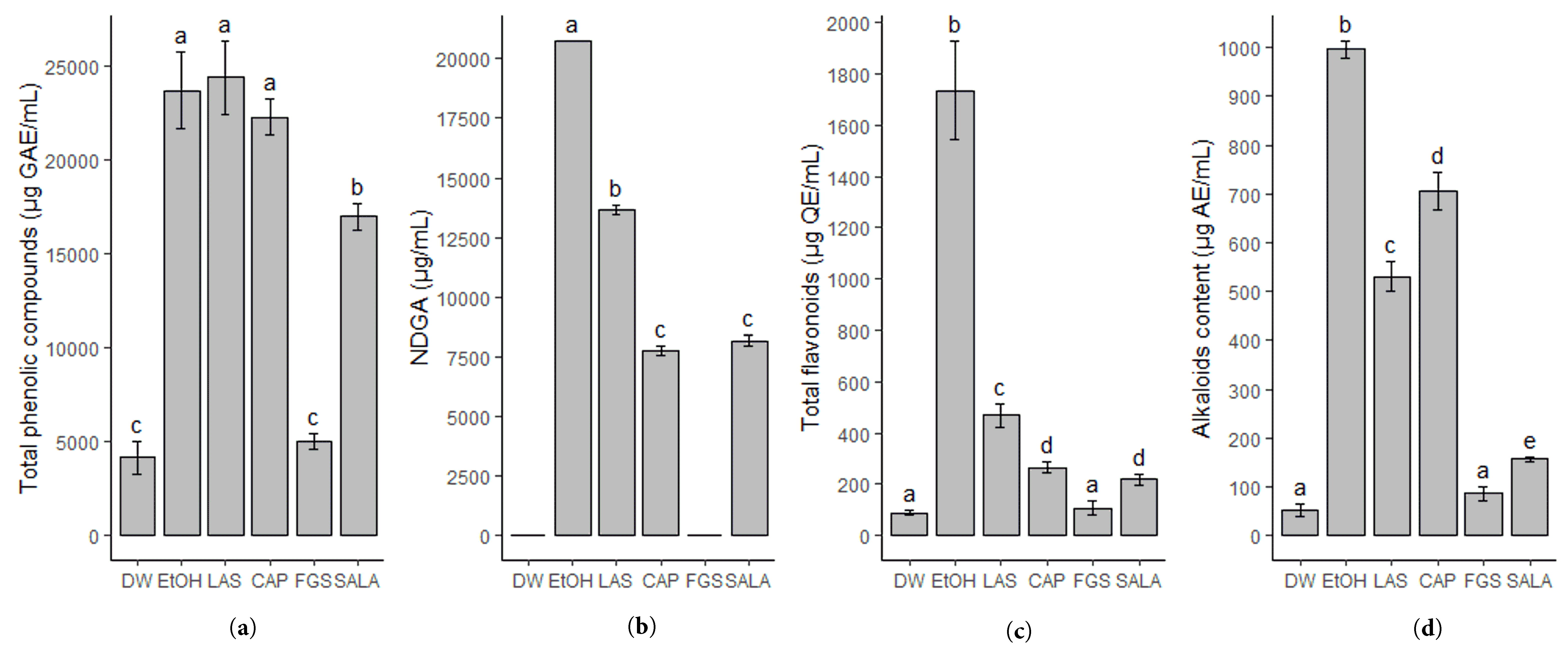
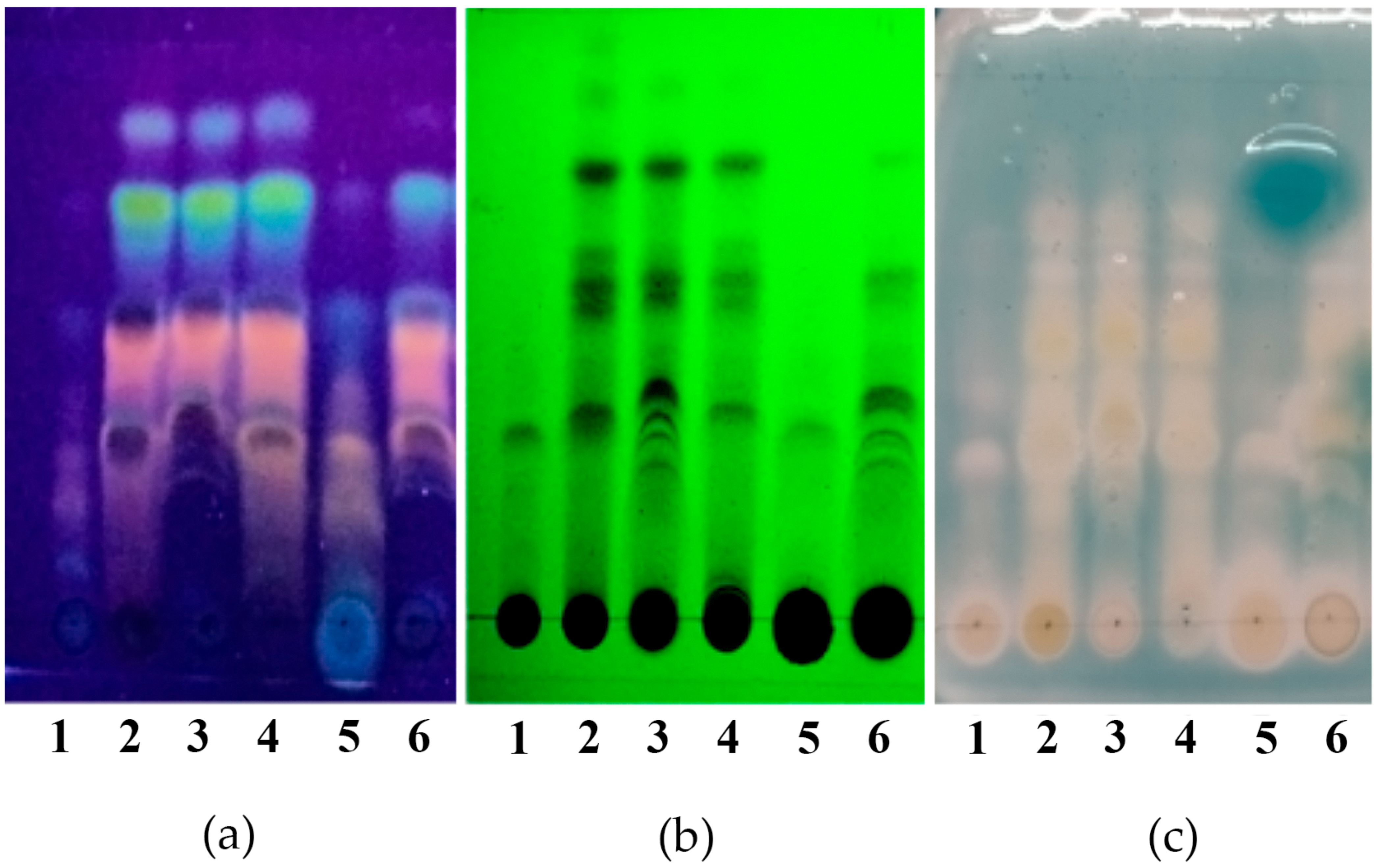
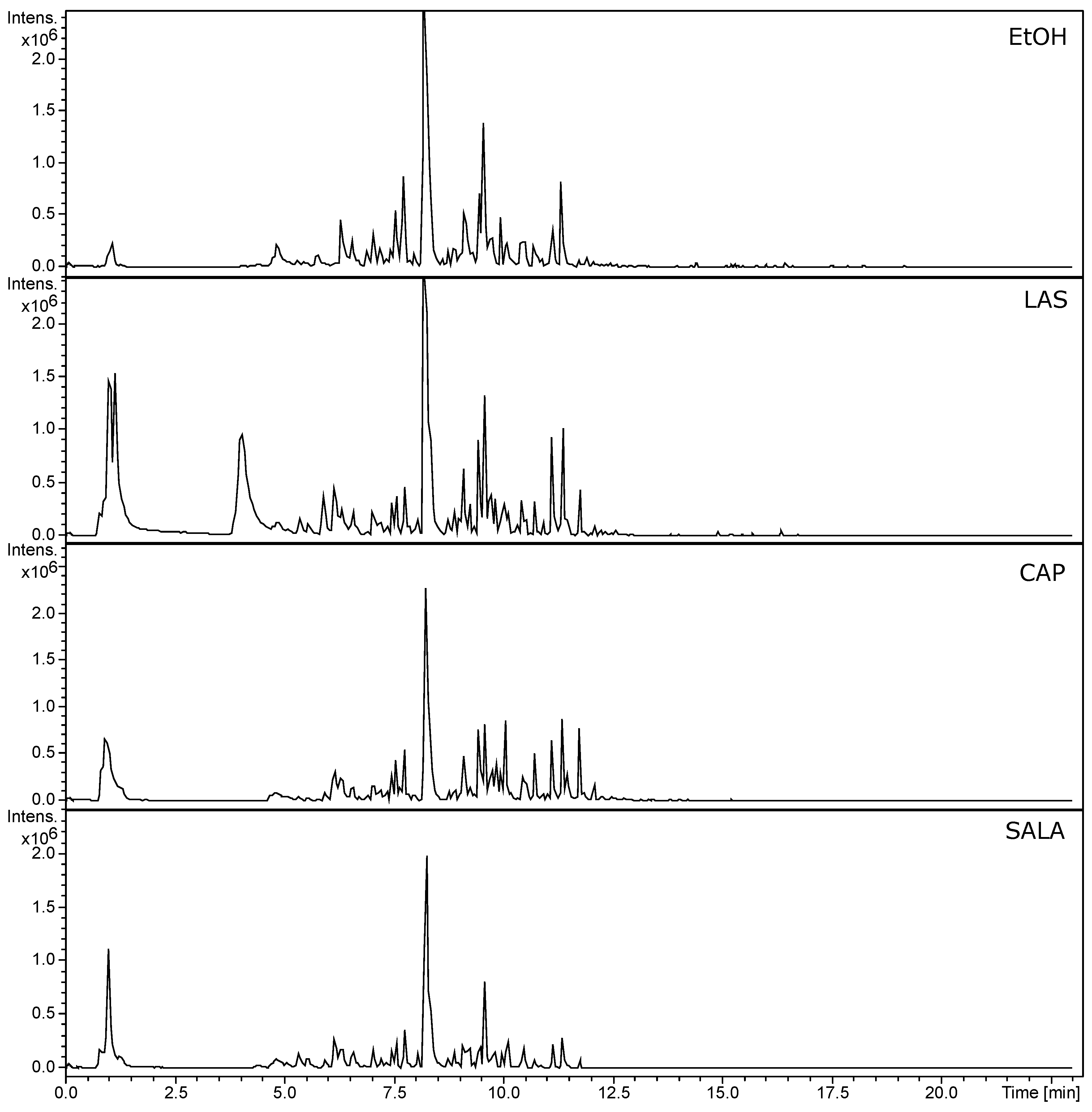
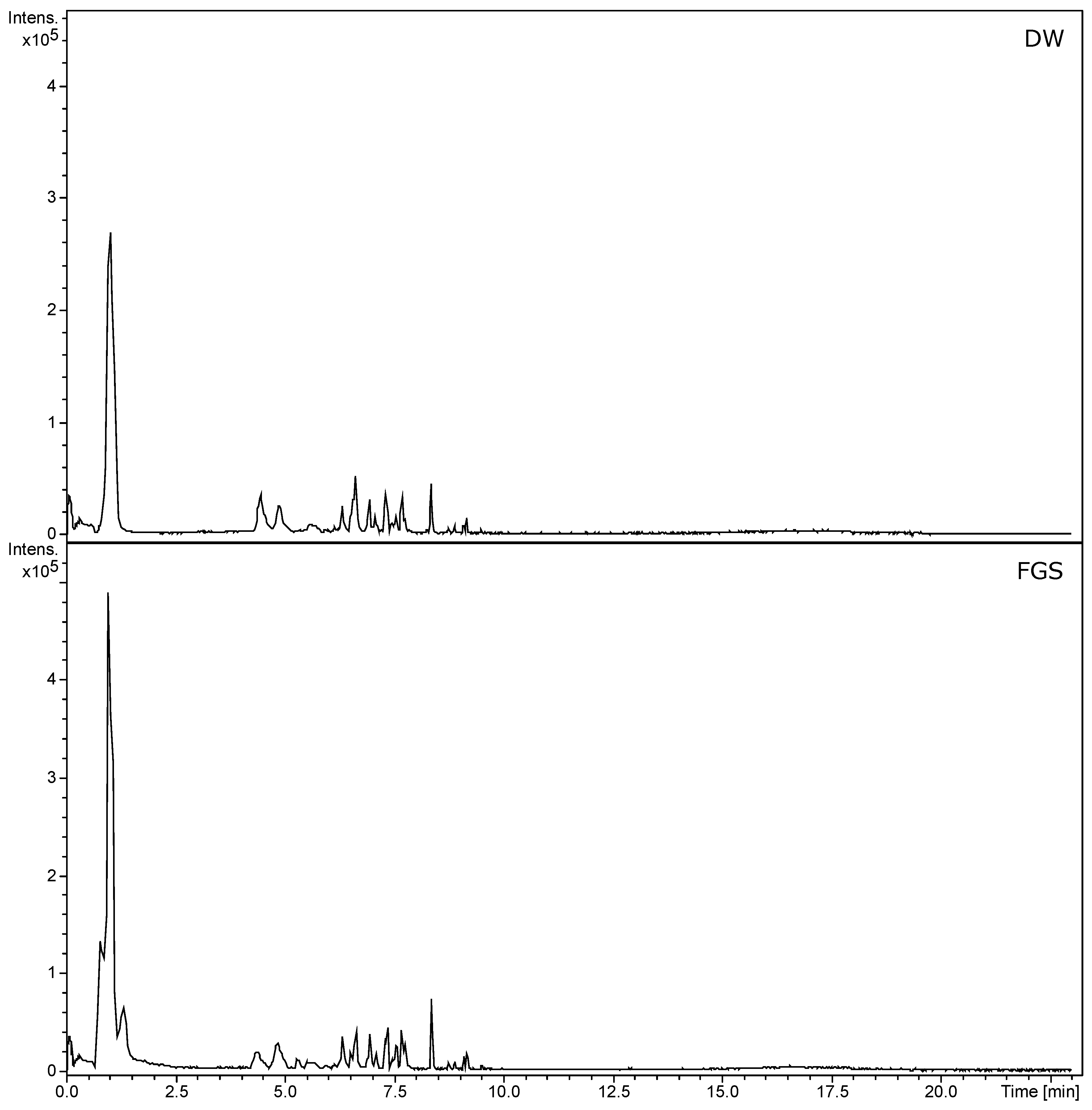
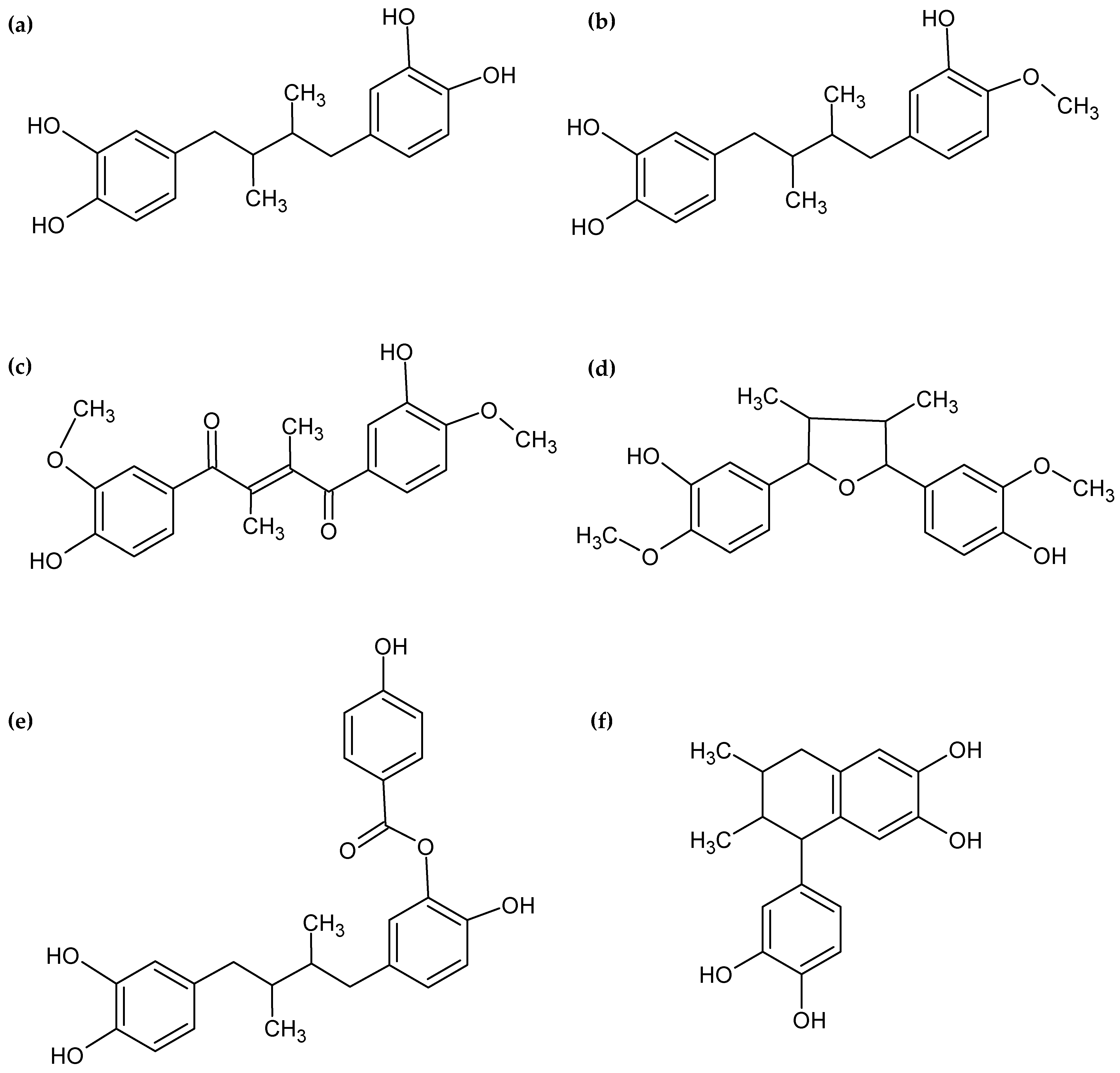
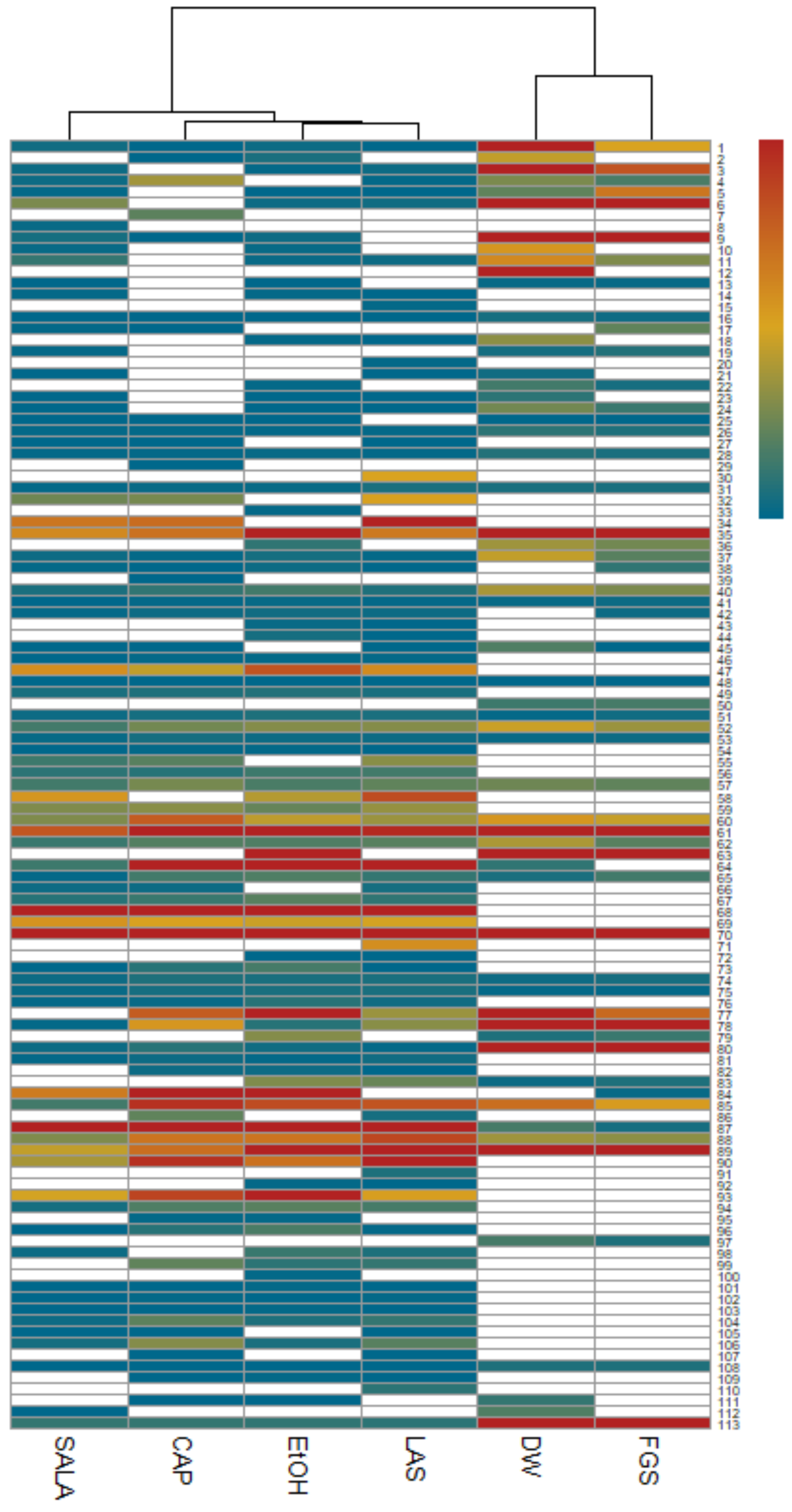
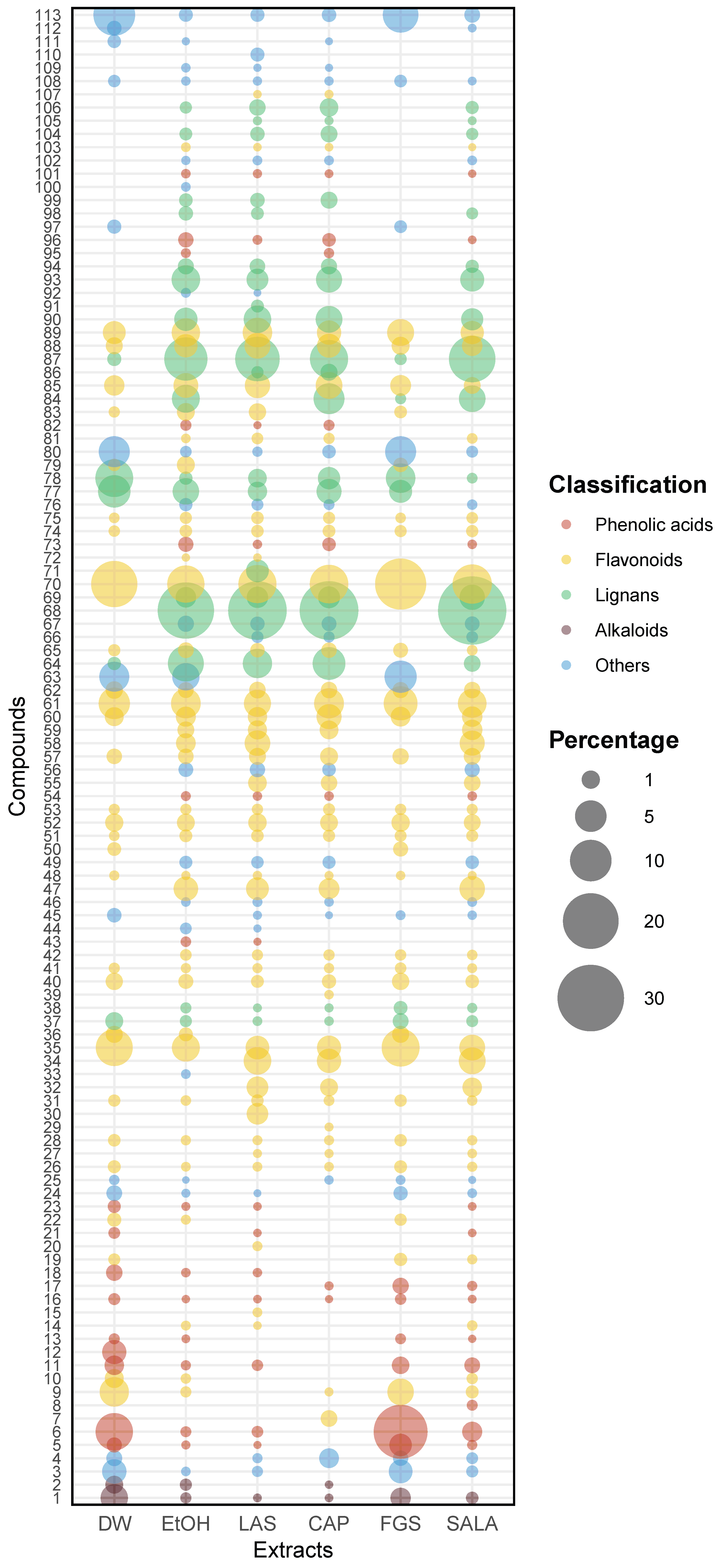
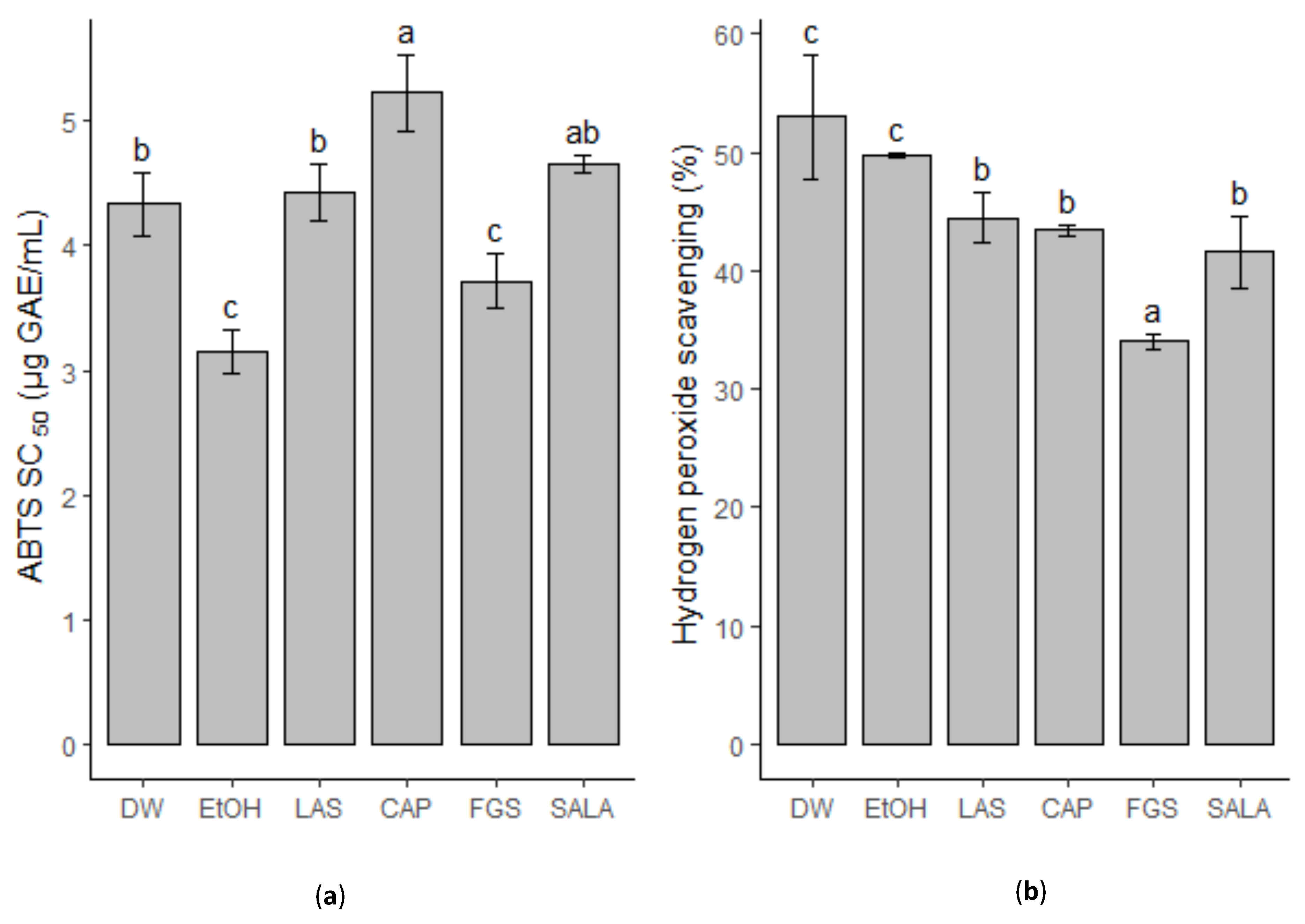
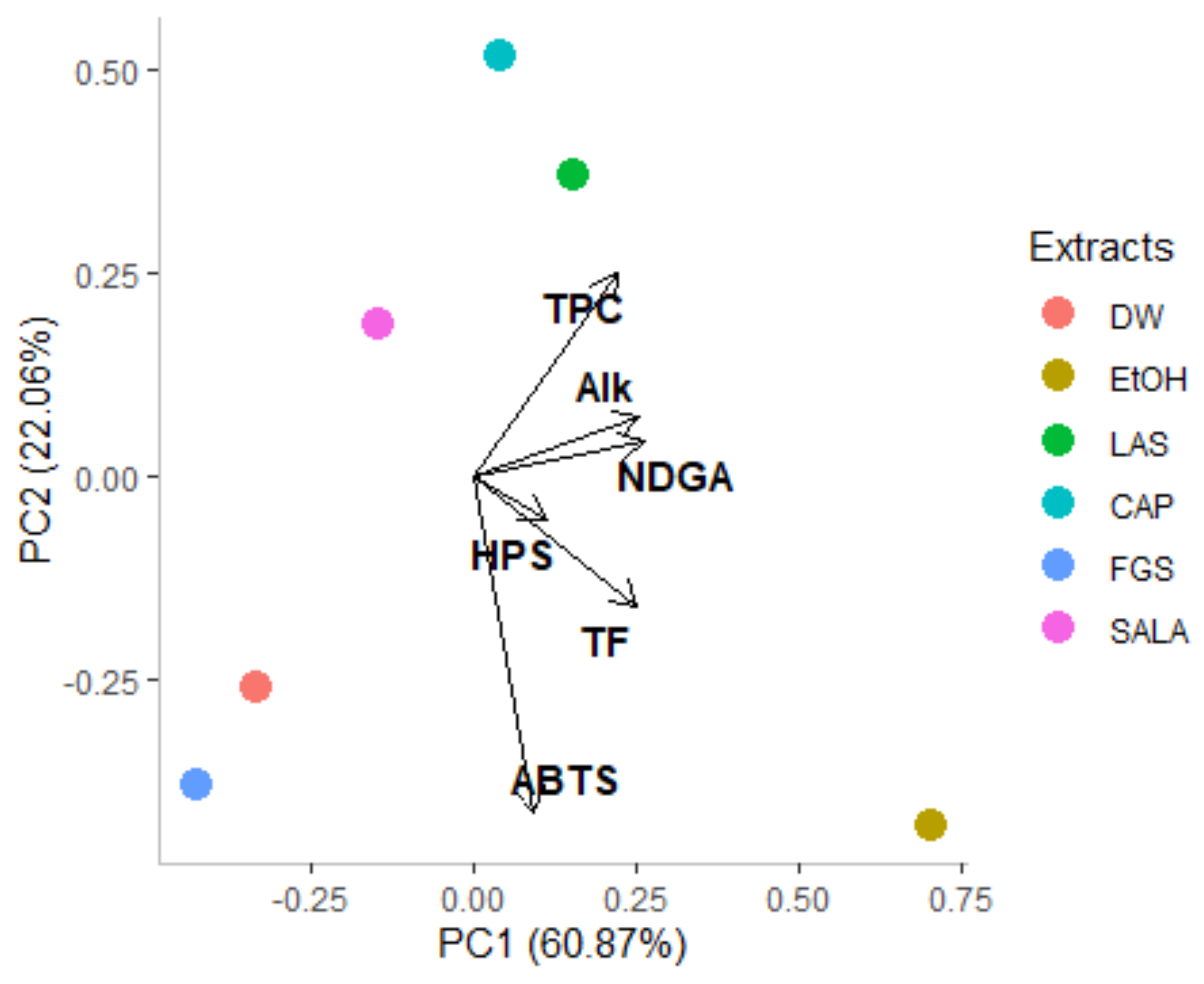
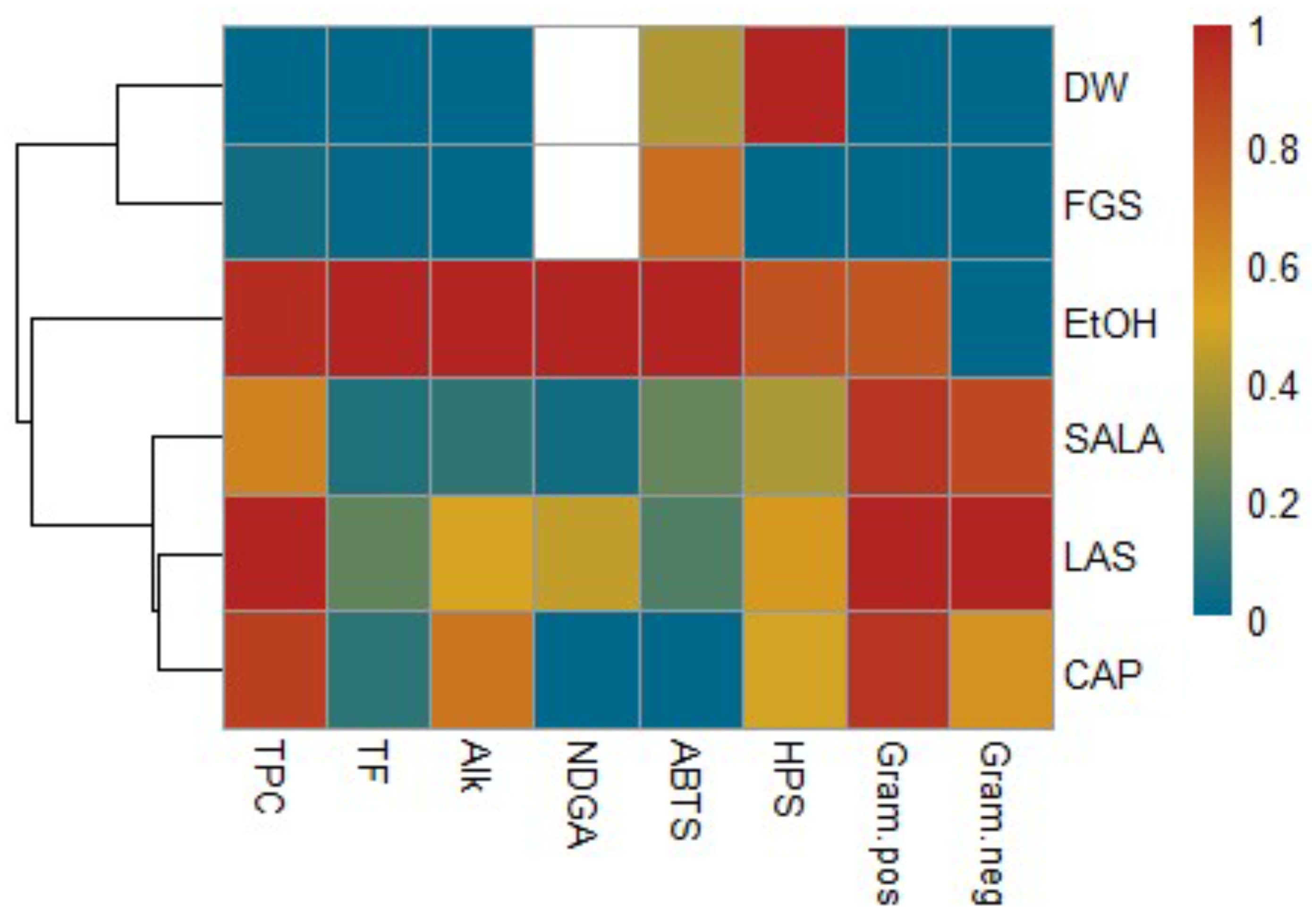
| Principal Components | PC1 | PC2 | PC3 | PC4 | PC5 | PC6 |
|---|---|---|---|---|---|---|
| Standard deviation | 1.9111 | 1.1505 | 0.9425 | 0.36549 | 0.04556 | 3.98 × 10−16 |
| Proportion of variance | 0.6087 | 0.2206 | 0.1480 | 0.02226 | 0.00035 | 0.000 |
| Cumulative proportion | 0.6087 | 0.8293 | 0.9774 | 0.99965 | 1.00000 | 1.000 |
| Eigen vectors | ||||||
| TPC | 0.4274 | 0.4807 | −0.1538 | −0.2068 | −0.1560 | 0.7038 |
| TF | 0.4878 | −0.3098 | −0.0497 | −0.0163 | 0.8105 | −0.0794 |
| NDGA | 0.5073 | 0.0818 | −0.1036 | −0.5558 | −0.2326 | −0.6016 |
| Alk | 0.4923 | 0.1389 | −0.0564 | 0.8026 | −0.2092 | −0.2167 |
| ABTS•+ | 0.1777 | −0.7976 | −0.2167 | −0.0286 | −0.4533 | 0.2805 |
| HPS | 0.2186 | −0.1026 | 0.9554 | −0.0535 | −0.1234 | 0.1030 |
| Microorganism | DW | EtOH | LAS | CAP | FGS | SALA | ||||
|---|---|---|---|---|---|---|---|---|---|---|
| C | Ext | C | Ext | C | Ext | C | Ext | |||
| S. aureus (n = 10) | >600 | 150 | 75 | 37.5 | 300 | 75 | >600 | >600 | 75 | 75 |
| S. aureus ATCC 29213 | >600 | 75 | 75 | 37.5 | 300 | 75 | >600 | >600 | 75 | 75 |
| S. aureus ATCC 43300 | >600 | 75 | 75 | 37.5 | 300 | 75 | >600 | >600 | 75 | 75 |
| S. epidermidis | >600 | 150 | 75 | 37.5 | 300 | 75 | >600 | >600 | 75 | 75 |
| E. faecalis ATCC 29212 | >600 | 150 | 75 | 37.5 | 300 | 75 | >600 | >600 | 75 | 75 |
| E. coli (n = 6) | >600 | >600 | 75–150 | 75 | 300 | 300 | >600 | >600 | 75–150 | 150 |
| E. coli ATCC 35218 | >600 | >600 | 75 | 75 | 300 | 300 | >600 | >600 | 75 | 150 |
| E. coli ATCC 25922 | >600 | >600 | 75 | 75 | 300 | 300 | >600 | >600 | 75 | 75 |
| K. pneumoniae (n = 5) | >600 | >600 | 75–150 | 75 | 300 | 300 | >600 | >600 | 150 | 150 |
| P. aeruginosa (n = 5) | >600 | >600 | 75 | 75 | 300 | 300 | >600 | >600 | 75 | 75 |
| P. aeruginosa ATCC 27853 | >600 | >600 | 75 | 75 | 300 | 300 | >600 | >600 | 75 | 75 |
Disclaimer/Publisher’s Note: The statements, opinions and data contained in all publications are solely those of the individual author(s) and contributor(s) and not of MDPI and/or the editor(s). MDPI and/or the editor(s) disclaim responsibility for any injury to people or property resulting from any ideas, methods, instructions or products referred to in the content. |
© 2025 by the authors. Licensee MDPI, Basel, Switzerland. This article is an open access article distributed under the terms and conditions of the Creative Commons Attribution (CC BY) license (https://creativecommons.org/licenses/by/4.0/).
Share and Cite
Conta, A.; Simirgiotis, M.J.; Martínez Chamás, J.; Isla, M.I.; Zampini, I.C. Extraction of Bioactive Compounds from Larrea cuneifolia Cav. Using Natural Deep Eutectic Solvents: A Contribution to the Plant Green Extract Validation of Its Pharmacological Potential. Plants 2025, 14, 1016. https://doi.org/10.3390/plants14071016
Conta A, Simirgiotis MJ, Martínez Chamás J, Isla MI, Zampini IC. Extraction of Bioactive Compounds from Larrea cuneifolia Cav. Using Natural Deep Eutectic Solvents: A Contribution to the Plant Green Extract Validation of Its Pharmacological Potential. Plants. 2025; 14(7):1016. https://doi.org/10.3390/plants14071016
Chicago/Turabian StyleConta, Agostina, Mario Juan Simirgiotis, José Martínez Chamás, María Inés Isla, and Iris Catiana Zampini. 2025. "Extraction of Bioactive Compounds from Larrea cuneifolia Cav. Using Natural Deep Eutectic Solvents: A Contribution to the Plant Green Extract Validation of Its Pharmacological Potential" Plants 14, no. 7: 1016. https://doi.org/10.3390/plants14071016
APA StyleConta, A., Simirgiotis, M. J., Martínez Chamás, J., Isla, M. I., & Zampini, I. C. (2025). Extraction of Bioactive Compounds from Larrea cuneifolia Cav. Using Natural Deep Eutectic Solvents: A Contribution to the Plant Green Extract Validation of Its Pharmacological Potential. Plants, 14(7), 1016. https://doi.org/10.3390/plants14071016











